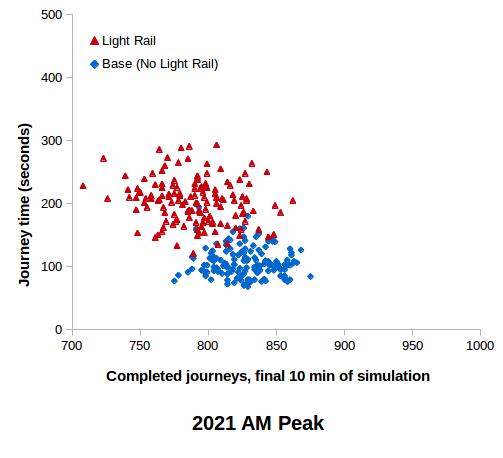Each scenario was run over 140 times using traffic volumes and signal timing from the Capital Metro Stage 1 EIS Volume 3, Part 5, Appendix B, and using the default model parameters from for the Intelligent Driver Model and, for the tram scenarios, 10 trams per hour in each direction. From each run, the first 50 minutes of journey data was ignored and from the final 10 minutes, a scatter graph of number of completed journeys was plotted against average completed journey time.
2021 AM Peak
Traffic volumes
| Scenario | N-E | N-S | N-W | E-S | E-W | E-N | S-W | S-N | S-E | W-N | W-E | W-S |
|---|---|---|---|---|---|---|---|---|---|---|---|---|
| Base | 95 | 1719 | 161 | 388 | 445 | 158 | 150 | 564 | 153 | 113 | 630 | 606 |
| Light Rail | 447 | 1551 | 144 | 370 | 406 | 172 | 138 | 563 | 201 | 95 | 584 | 563 |
| Change with Light Rail | +352 | -168 | -17 | -18 | -39 | +14 | -12 | -1 | +48 | -18 | -46 | -43 |
The increase of 352 vehicles N-E with light rail is caused by changes at Swinden St: this turn will be less used as the service road now used to turn onto Antill will be no-longer connected to Northbourne Av.
The big decrease of 168 vehicles N-S with light rail is probably overestimated: the modelling with light rail shows 2126 from north southbound at Swinden with a further 55 vehicles turning south at Swinden, for a combined southbound flow leaving Swinden of 2181. A total of 591 turn left or right at Mouat/Antill, leaving 1590 travelling south (not the 1551 reported by the CMA model). Nevertheless, this simulation uses the CMA model's numbers, but notes they are probably "optimistic".
It is also unclear why the traffic originating from Mouat (from the west) is significantly less with the light rail model, as this traffic mostly originates from North Lyneham and Belconnen, areas not serviced by the light rail. This seems particularly strange, as the significant increase in the S-E traffic with light rail suggests Antill St is a much more popular destination with light rail for traffic originating from the south, but not from the west.
Similarly, a reduction in S-N volume would be expected with the tram, but that figure is basically unchanged.
The CMA model does not explain these difference in modelled flows. A cynic would be tempted to observe that the increases in traffic volumes with the light rail are largely with the unsignalled N-E flow and totally restricted to the lower-volume and uncongested flows, and decreases are modelled to the congested flows, despite the differences being inconsistent (as is the case with the W-E flows). Nevertheless, this simulation uses the CMA model's numbers.
Results

| Scenario | Average journey time (sec) |
Standard deviation(sec) |
|---|---|---|
| Base (No Light Rail) | 106 | 24 |
| Light Rail | 204 | 35 |
The light rail increases average intersection delay by almost 100 seconds, despite the vehicles travelling through the signalled flows falling by over 250.
Hence ignoring flow-on effects of congestion at the new signalised intersection to the north at Swinden and the expanded crossing to the south at Murdoch, and similar increased congestion at intersections further north and south, vehicles could expect an additional 100 seconds delay at this intersection in the AM peak in 2021 if the light rail is built.
2031 AM Peak
Traffic volumes
| Scenario | N-E | N-S | N-W | E-S | E-W | E-N | S-W | S-N | S-E | W-N | W-E | W-S |
|---|---|---|---|---|---|---|---|---|---|---|---|---|
| Base | 118 | 1765 | 148 | 450 | 406 | 195 | 148 | 655 | 185 | 111 | 649 | 555 |
| Light Rail | 674 | 1907 | 143 | 440 | 411 | 220 | 138 | 679 | 203 | 116 | 641 | 520 |
| Change with Light Rail | +556 | +142 | -5 | -10 | +5 | +25 | -10 | +24 | +18 | +5 | -8 | -35 |
Again, the large increase of 556 vehicles N-E with light rail is caused by changes at Swinden St.
It is unclear why the W-S traffic originating from Mouat (from the west) turning right (south) is less in 2031 than 2021, with both models.
Results

| Scenario | Average journey time (sec) |
Standard deviation(sec) |
|---|---|---|
| Base (No Light Rail) | 102 | 21 |
| Light Rail | 313 | 42 |
The light rail increases average intersection delay by over 200 seconds despite the vehicles travelling through the signalled flows increasing by just 166 vehicles (less than 4%) compared to the base case.
It may seem strange that the average delay with 2031 Base (No Light Rail) traffic is slightly lower than the corresponding 2021 Base delay. The reasons seem to be:
- Less signalled cross traffic in aggregate in 2031, in the model used by the CMA EIS.
- the NS signal time is one second less in the 2031 signal timings used by the CMA EIS. This gives slightly more signal time per hour to the other traffic flows which tend to be more congested.
Hence ignoring flow-on effects of congestion at the new signalised intersection to the north at Swinden and the expanded crossing to the south at Murdoch, and similar increased congestion at intersections further north and south, vehicles could expect an additional 200 seconds delay at this intersection in the AM peak in 2031 if the light rail is built.
